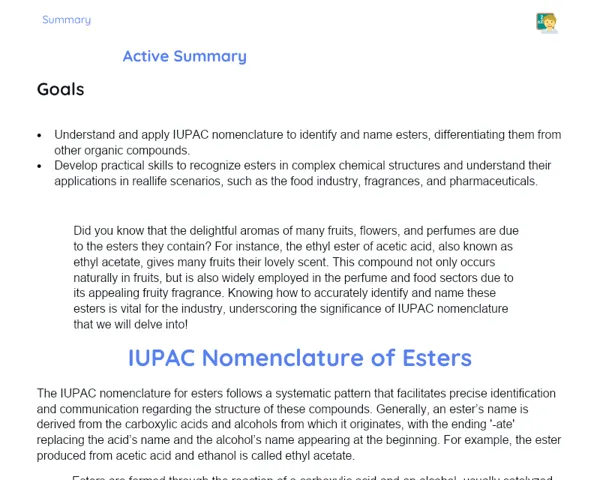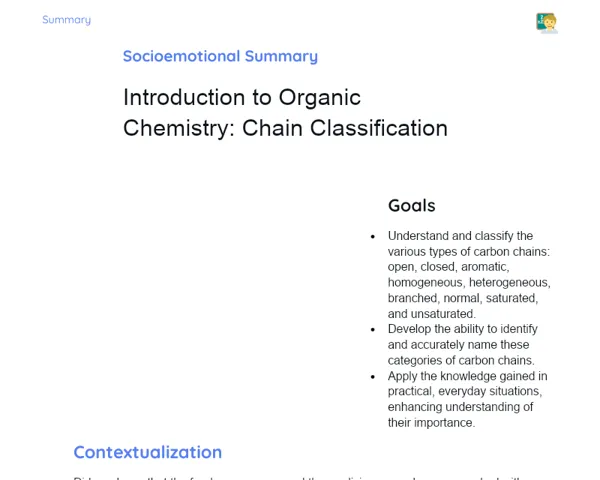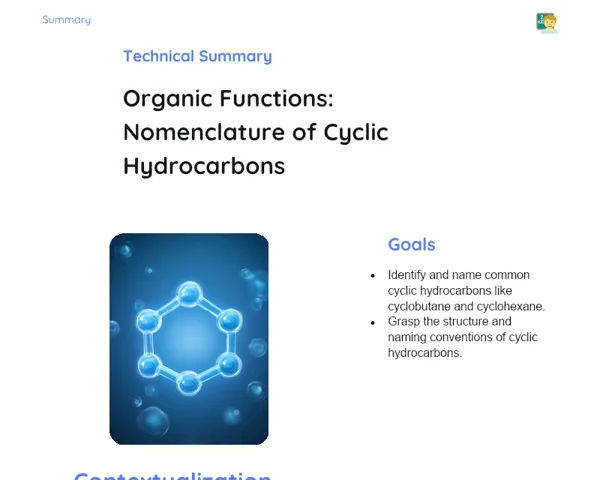Goals
1. Grasp the basics of classifying carbon chains as open, closed, aromatic, homogeneous, heterogeneous, branched, linear, saturated, and unsaturated.
2. Learn how to identify various carbon chain types in real-life examples.
3. Encourage critical thinking and problem-solving abilities through the identification and classification of carbon chains.
4. Foster teamwork and collaboration during practical sessions.
Contextualization
Organic Chemistry is a captivating area of chemistry focused on carbon compounds. This field is vital for comprehending the biological and chemical processes occurring in our surroundings, with direct implications in sectors such as pharmaceuticals, petrochemicals, and food. For instance, synthesizing new medicines, creating alternative fuels, and designing innovative plastic materials are all practical applications of Organic Chemistry. Classifying carbon chains is essential for understanding the characteristics and reactivities of organic compounds, leading to significant progress in various technological arenas.
Subject Relevance
To Remember!
Open and Closed Carbon Chains
Carbon chains can be categorized as open (or acyclic) and closed (or cyclic). Open chains have free ends, while closed chains form loops. This categorization is basic for understanding the physical and chemical attributes of organic compounds.
-
Open Chains: Have free ends and can be either linear or branched.
-
Closed Chains: Form loops and can be homogeneous (only carbon and hydrogen) or heterogeneous (with other atoms).
-
Importance: Affects the reactivity and physical characteristics of compounds.
Aromatic Chains
Aromatic chains contain at least one benzene ring—a cyclic structure with six carbon atoms and three conjugated double bonds. These chains are remarkably stable due to electronic resonance.
-
Benzene Ring: Composed of six carbon atoms with alternating double bonds.
-
Resonance: Enhances the chemical stability of aromatic chains.
-
Usage: Commonly found in pharmaceutical compounds and materials like plastics and resins.
Homogeneous and Heterogeneous Chains
Homogeneous chains consist exclusively of carbon and hydrogen atoms, while heterogeneous chains include additional atoms such as oxygen and nitrogen. The presence of these different atoms greatly alters the properties of the compounds.
-
Homogeneous Chains: Made only of carbon and hydrogen.
-
Heterogeneous Chains: Incorporate other elements like oxygen, nitrogen, sulfur, etc.
-
Impact: The presence of heteroatoms modifies the polarity, solubility, and reactivity of compounds.
Practical Applications
-
Pharmaceutical Industry: The classification of carbon chains plays a crucial role in developing effective and safe drugs.
-
Petrochemical Industry: Open and branched carbon chains are vital for producing more effective and less polluting fuels.
-
Food Industry: Carbon chains are essential for formulating preservatives and additives that enhance food quality and shelf life.
Key Terms
-
Open Chain: A carbon chain with free ends.
-
Closed Chain: A carbon chain that forms a loop.
-
Aromatic Chain: A carbon chain featuring a benzene ring.
-
Homogeneous Chain: A carbon chain composed solely of carbon and hydrogen atoms.
-
Heterogeneous Chain: A carbon chain containing atoms other than carbon and hydrogen.
Questions for Reflections
-
How does the understanding of carbon chains influence the development of new medicines?
-
In which ways can classifying carbon chains aid in producing more sustainable fuels?
-
What significance does accurately identifying carbon chains hold in the food sector?
Classifying Chains in Everyday Products
Identify and classify the carbon chains found in everyday products.
Instructions
-
Select 5 different products that you use regularly (for example, medications, packaged foods, cleaning products).
-
Research their chemical compositions and identify an organic compound in each.
-
Sketch the structures of the carbon chains of these compounds and classify them as open, closed, aromatic, homogeneous, heterogeneous, branched, linear, saturated, or unsaturated.
-
Compose a brief paragraph explaining the importance of classifying these carbon chains for the product's functionality.



